Product Development Department
Product Management Division
YANMAR SHIP BUILDING & ENGINEERING CO.,LTD.
YANMAR Technical Review
Technology for Improving Comfort in Small Pleasure Boat: Wakuwaku-Boat Technology
Abstract
The major factors in pleasure boat comfort are auditory, visual, and tactile.
The noise and vibration are the first things people notice when riding in a boat, and there has been ongoing research into how to reduce the level of sound pressure, particularly as the spread of the mobile phone.
Recent years have also seen a rapid increase in the level of market demand for dealing with discomfort arising out of the visual or tactile, meaning the colors and brightness to which the eyes are exposed, and how things feel to the touch. Also in demand are techniques for preventing discomfort due to insufficient air conditionings and the rolling and impact that occur when the boat is in cruising.
This article describes the techniques adopted on the Wakuwaku-Boat in response to these high demands in the level of comfort.
1. Introduction
Among the requirements for pleasure boats are that they provide the comfort to enhance the excitement of travelling across the open sea, and the delight in cruising and in spending time ensconced in comfort in a bright and open luxurious personal space.
This article describes techniques for enhancing ride comfort and providing more attractive interiors and pleasant spaces.
An EX33A2 pleasure boat was used as base for building a prototype boat.
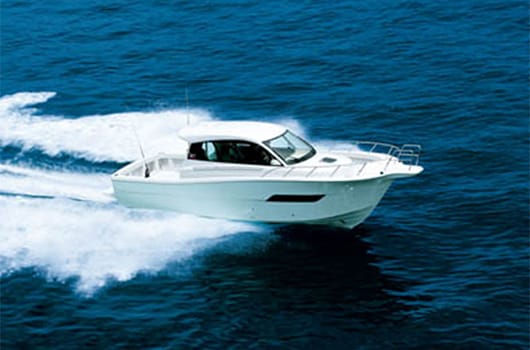

Fig. 1
2. Challenges
2.1. Ride Comfort Improvement
A cruising boat is subject to considerable impact energy from ocean waves (see Fig. 2).

This impact is transmitted through the hull and is a major cause of discomfort to people in the boat. Unpleasant sounds (chattering and creaking) are also produced by the propagation of this impact and this is another major cause of discomfort to people in the boat.
The challenge is how to reduce this impact propagation.
2.2. Attractive Interior
To make the interior attractive, it is necessary to adopt new design techniques that transform the impressions that people receive via their visual and tactile senses. The adoption of interior design practices from the automotive industry is also needed to incorporate new technologies for internal panels.
The challenge is to produce designs that transform how the interior is perceived.
2.3. Comfortable Spaces
Ways of providing comfortable spaces include suitable air conditioning design and building spaces that are calming and feel open and airy. As exposure to direct sunlight is impossible to avoid when going out on a boat, thermal energy enters the cabin through the boat's FRP walls and window glass (see Fig. 3).
Also, warm air tends to accumulate in higher spaces and this can add to discomfort if not circulated (see Fig. 4).
The challenges are to minimize the amount of thermal energy entering the boat, to optimize air conditioning design to provide efficient circulation, and to utilize the ambience provided by indirect illumination.
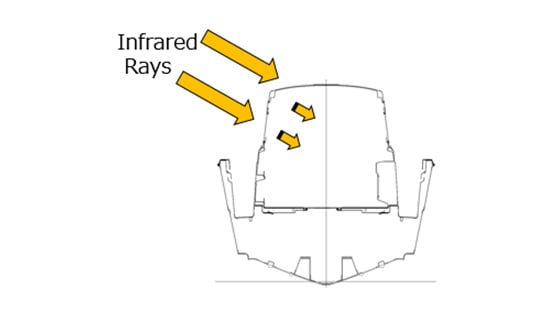
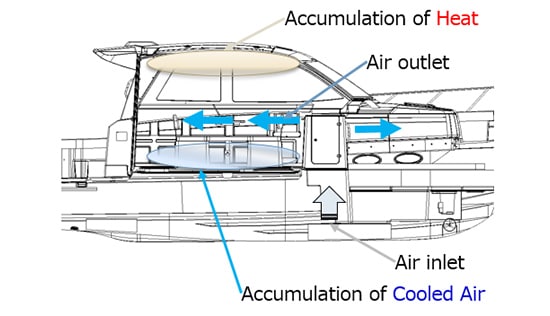
3. Details of Experimental Research
3.1. Ride Comfort Improvement (Reducing of Impact Propagation)
The following two approaches to reduce impact propagation can be considered.
- Boat design improvements to prevent the generation of impacts
- Use of a high-rigid hull to prevent propagation
The experimental research described here left the boat design unchanged and focused instead on making the hull rigid to prevent propagation.
(1) Hull structure
As shown in Fig. 5, a conventional laminated hull structure has only a single panel. In place of this, tests were conducted on using vacuum-forming to increase rigidity and a sandwich structure adopted (see Fig. 6).
The flexural rigidity (EI) was calculated for a cross section through the mid-part of the hull.

(2) Damping of impact acceleration
Fig. 7 shows the acceleration over time due to a hull impact when panting through waves.
The blue line is for the previous single-panel hull and the red-line for the sandwich-panel hull produced by vacuum forming.
This shows how the higher rigidity compared to the single-panel hull results in more rapid damping.

(3) Reduction in noise level
Measurements of the reduction in the level of wave impact noise in the berth space of the boat found that the levels were 84.4 dB(A) for the standard boat and 81.2 dB(A) for the prototype boat.
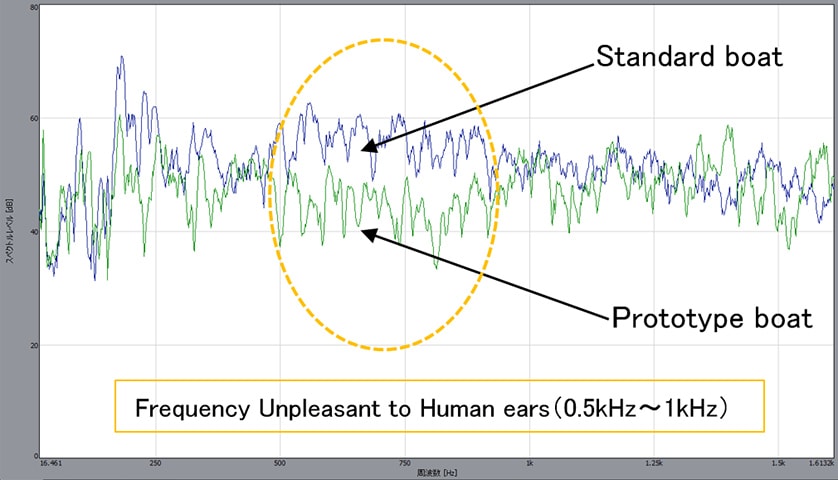
(4) Sensory evaluation
A sensory evaluation of the prototype boat during cruising was performed using the results of the standard boat as the reference.

(5) Results
The changes in hull structure increased the flexural rigidity (EI) of the hull by 20 % and reduced impact propagation by improving the damping of acceleration, while also reducing the hull mass by 150 kg.
The sound pressure measurement found an improvement of 3.24 dB in the berth space.
The sensory evaluation found an overall improvement of 38 % relative to the standard boat.
The results indicate that the adoption of the rigid hull reduced impact propagation, minimized the creaking and chattering that are discomforting for people onboard, and enhanced comfort during cruising.
3.2. Attractive Interior (Design that Transforms How Interior is Perceived)
(1) Design concept
Designs for the cabin ceiling and berth walls that were based on the aims of improving appearance and creating a tidy and comfortable space were devised in collaboration with a manufacturer with experience of vehicle interiors in the automotive industry.
(2) Design implementation
The designs were implemented on the prototype boat. Fig. 10 shows comparative photographs of the standard and prototype boat interiors.
The base material used was a glass fiber/polypropylene composite (GF/PP) that is both light and rigid, with the exterior surfaces being arranged so as to change the impression and feel of the cabin ceiling and berths.
The GF/PP material is a soft cushiony material that has an inviting feel.
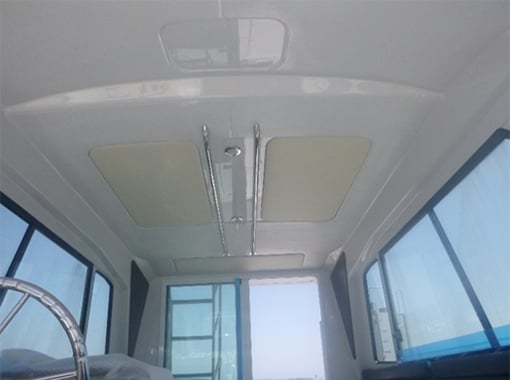
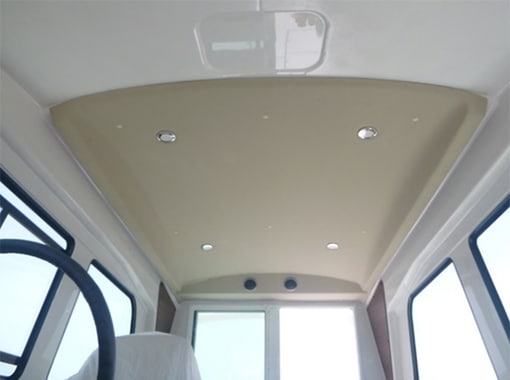
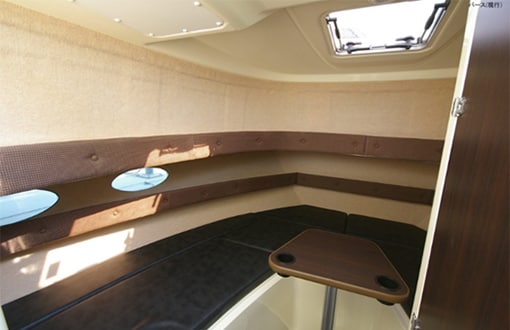

Fig. 10
(3) Sensory evaluation
A sensory evaluation was conducted for the berth and cabin spaces.
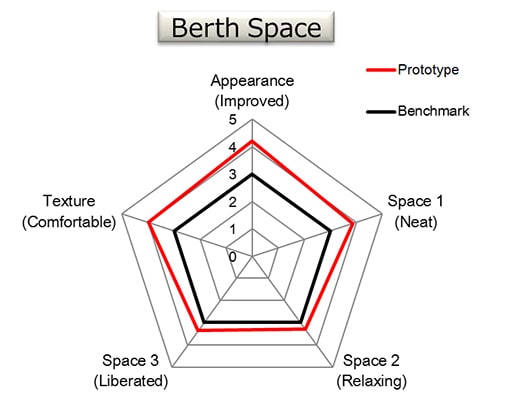
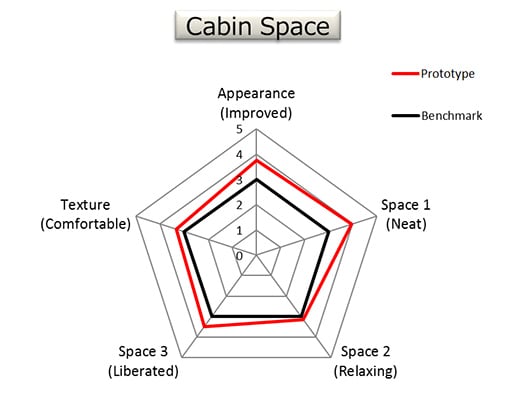
(4) Results
Impressions of the berth space were 37 % higher and for the cabin space were 27 % higher.
These results indicate that the design succeeded in transforming how the interior is perceived, creating an attractive interior that is tidy and relaxing.
3.3. Comfortable Spaces
(1) Thermal insulated cabin
The proportion of glass window to the cabin sides has increased over the last few years to make the cabin feel more open and to improve visibility. A consequence of this is a higher flux of infrared ray coming through the windows, creating a need to provide a comfortable level of air conditioning and prompting the adoption of cabin thermal insulation.
For the FRP panels used in the roof and sides of the cabin, the fiberglass with a three-dimensional hollow structure in which air layers can be formed. Coating the window glass with an insulating film that can block infrared rays has also been adopted.
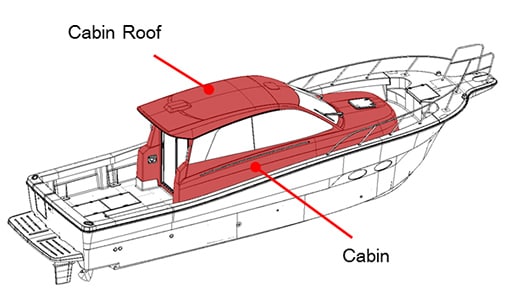

Fig. 13
(a) Thermal insulation performance of panel
Fig. 14 shows a cross section of the cabin wall panels used for the standard craft. Fig. 15 shows a cross section of the cabin wall panels made using continuous three-dimensional hollow structural glass fiber.

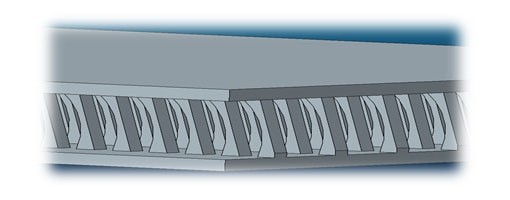
A comparison found that the new cabin wall has two times of thermal insulation performance when the thermal conductivity is measured and the thermal resistance is compared.
Table 1
| Test Piece | Thickness | Thermal conductivity | Thermal resistance | Comparison of thermal insulation performance | |
|---|---|---|---|---|---|
| Name | Material structure | mm | W/(m K) | R value | |
| Standard boat | MMMRM+MMM | 6.5 | 0.14 | 46.4 | Standard boat : Prototype boat 1:2.1 |
| Prototype boat | MM+PG/5+MM | 10.0 | 0.10 | 100.0 | |
(b) Thermal insulation performance of thermal insulation film
The temperatures in the cabin at 100 mm from the window with clear plain glasses and those coated with thermal insulating films are measured and compared. The effect of the thermal insulating film (A) was 7.9 °C after 300 seconds.
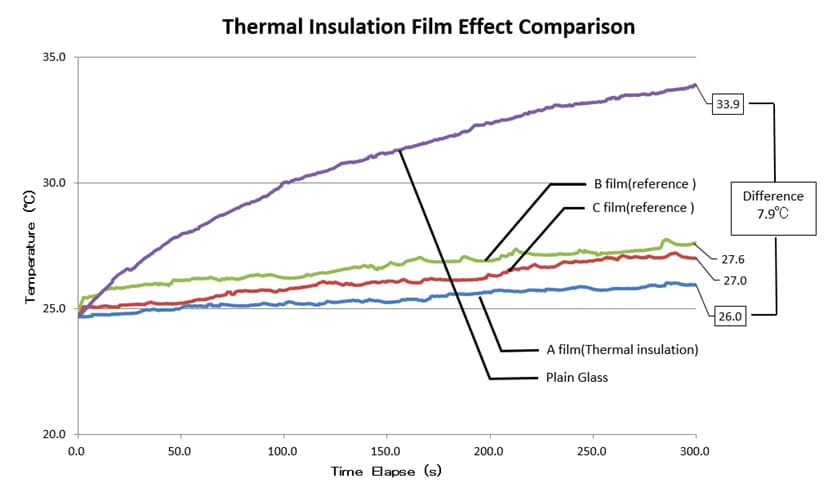
(c) Performance of thermal insulated cabin
The cabin thermal insulation was found to reduce the required cooling performance totally by 18.5 %, thereby allowing the air conditioner to be downsized.
- Required cooling performance (calculated)
Standard cabin: 4,514 kcal/h (5.24 kW)
Insulated cabin: 3,678 kcal/h (4.27 kW)
(2) Improved air circulation
Space constraints on small boat have made it difficult in the past to locate the air conditioning outlet at an elevated location. On the prototype boat, locating the air conditioning outlet in the ceiling was made possible by means of adopting slim ceiling ducts that were the subject of a study of vehicle interiors.
This enhances air circulation and provides a pleasant space that is not prone to draughts.
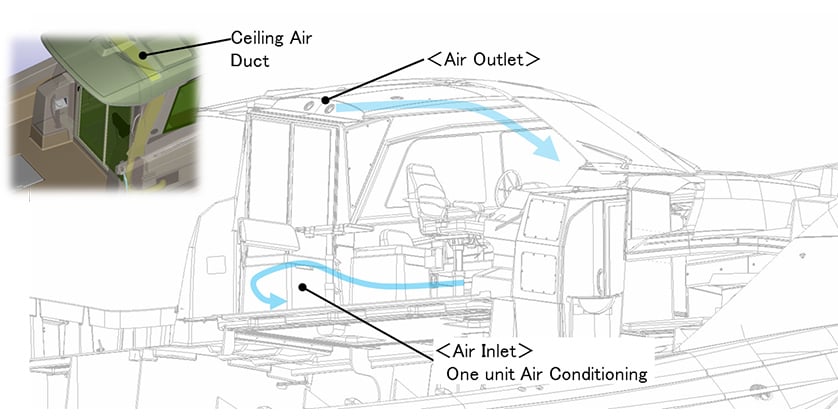
(3) Improved ambience achieved by use of indirect lighting
The use of indirect LED lighting in the cabin ceiling and the walls of the berth space was adopted to provide a more calming atmosphere. This soft and unobtrusive lighting provides a relaxing space with an enhanced sense of leisure.
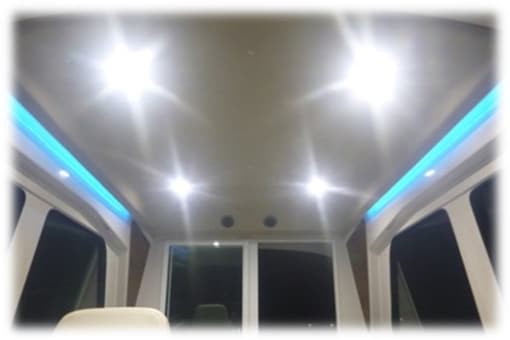
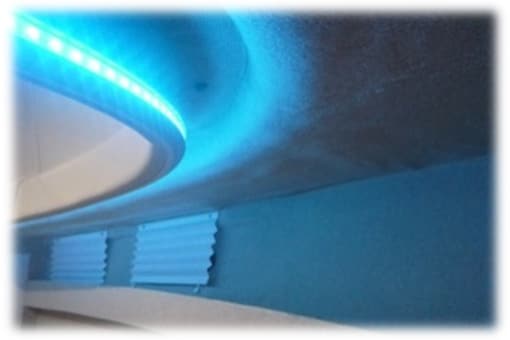
Fig. 18
4. Use in Production Models
The high-rigid hull intended to reduce discomfort when the boat is in cruising was adopted in 2016 for the production model of the FM28B pleasure boat. The newly developed EX34, meanwhile, entered commercial production in 2017 featuring both the high-rigid hull and the attractive interior design for the berth space. In the case of the techniques for providing comfortable spaces, however, further evaluation is needed to determine the cost of adopting these in production models.
5. Conclusions
The Wakuwaku Boat completed a design study and trial production in 2015 and testing and evaluation in 2016.
Work on the Wakuwaku II, designed for extreme ride comfort, is proceeding and as of this time (2017) is undergoing trial production. In the future, Yanmar will continue striving to satisfy rising market demands and to deliver value that exceeds customer expectations.
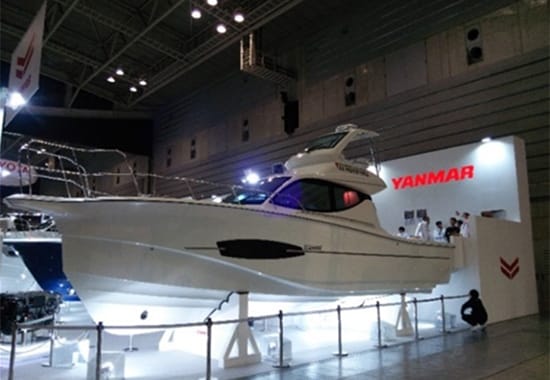
Featuring Wakuwaku technology
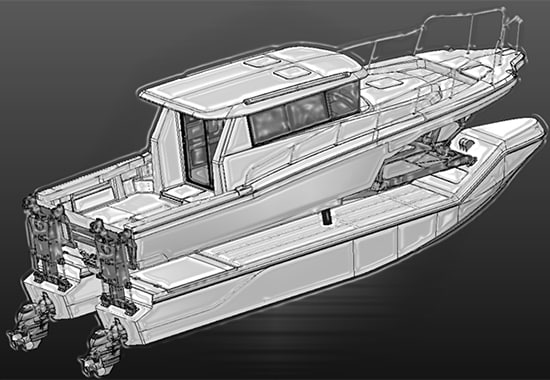
Work is underway on Wakuwaku II
Fig. 19
-IMPORTANT-
The original technical report is written in Japanese.
This document was translated by Research & Development Management Division.
Author
